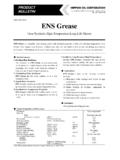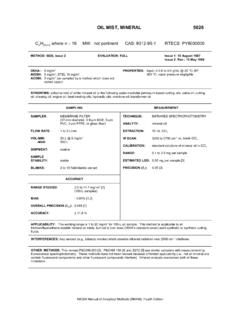Transcription of Safety in gas welding, cutting and similar processes
1 Health and Safety Executive Safety in gas welding , cutting and similar processes This leaflet is for people who use compressed gases for welding , hot cutting and similar processes . It describes the hazards associated with Safety in gas welding , cutting portable oxy/fuel gas equipment and the precautions for avoiding injury and similar processes Subhead subhead run on and damage to property. Introduction Oxy/fuel gas equipment has many uses - welding , cutting , heating, straightening, and descaling. The equipment is versatile, easy to move and cheap. It is so widely used that sometimes people forget about the dangers. Many people are injured each year by the incorrect or careless use of oxy/fuel gas equipment. Some people die. This leaflet describes the hazards associated with portable oxy/fuel gas This is a web-friendly version equipment and the precautions for avoiding injury and damage to property. of leaflet INDG297(rev1), published 05/12 The main hazards are: fire caused by heat, sparks, molten metal or direct contact with the flame.
2 Explosion when cutting up or repairing tanks or drums which contain or may have contained flammable materials;. fire/explosion caused by gas leaks, backfires and flashbacks;. fumes created during flame cutting ;. fire/burns resulting from misuse of oxygen;. burns from contact with the flame or hot metal;. crushing or impact injuries when handling and transporting cylinders. Page 1 of 11. Health and Safety Executive Figure 1 Two cylinders Safety in gas welding , cutting and similar processes Page 2 of 11. Health and Safety Executive Preventing fire from heat, sparks, molten metal or direct contact with flame The flame from an oxy/fuel gas torch (often called a blowpipe') is a very powerful source of ignition. Careless use of oxy/fuel torches has caused many fires. The flame will quickly set light to combustible material such as wood, paper, cardboard, textiles, rubber, and plastics. Many processes also generate sparks and hot spatter which can also ignite these materials.
3 The following precautions will help prevent fire: move the workpiece to a safe location for carrying out hot work;. remove nearby combustible materials (such as flammable liquids, wood, paper, textiles, packaging or plastics);. protect nearby combustible materials that cannot be moved. Use suitable guards or covers such as metal sheeting, mineral fibre boards or fire-retardant blankets;. check that there are no combustible materials hidden behind walls or in partitions, particularly if the welding or cutting will go on for some time. Some wall panels contain flammable insulation materials, eg polystyrene;. use flame-resistant sheets or covers to prevent hot particles passing through openings in floors and walls (doorways, windows, cable runs, etc);. if the consequences of a fire are severe, eg work inside ships, you may need to appoint a fire watch during and after the work finishes. It is normal to maintain fire watch for 30 minutes after hot work finishes.
4 Prevent flame, heat, sparks or hot spatter from landing on the hoses;. keep fire extinguishers nearby. Safety in gas welding , cutting and similar processes Page 3 of 11. Health and Safety Executive Explosion when cutting up or repairing tanks, drums and tyres Figure 2 cutting up scrap If a welding blowpipe or burner is used on a tank or drum containing flammable material (solid, liquid or vapour), it can explode. Such explosions have killed people. As well as flammable liquids such as petrol, diesel and fuel oil, substances such as paints, glue, anti-freeze and cleaning agents may also release flammable vapours. Tanks and drums that are empty' usually still have residues in the bottom, and in seams and crevices. Just a teaspoon of flammable liquid in a drum can be enough to cause an explosion. Never use an oxy/fuel gas blowpipe on a drum or tank that has contained, or may have contained, flammable material, unless you know it is safe. It may be safer for a specialist company to carry out the work.
5 If in doubt, ask. HSE has specific guidance on cleaning and inerting drums and tanks for hot work. Tyres The heat from hot work can generate flammable vapour from any oil or flammable residue on the inner rim of the wheel. The rubber itself can degrade when heated and release flammable materials. This vapour, confined by the tyre can cause an explosion. These explosions are very violent and can kill. Avoid welding or flame cutting on wheels which have tyres fitted, even if the tyre is deflated. If you can't remove the tyre, use cold cutting methods, eg a saw or hydraulic shears. Safety in gas welding , cutting and similar processes Page 4 of 11. Health and Safety Executive Fire/explosion caused by gas leaks Acetylene, LPG and other fuel gases are highly flammable, and form explosive mixtures with air and oxygen. Even small leaks can cause a flash fire or explosion, particularly if they are leaking into a poorly ventilated room or confined space where the gases can accumulate.
6 Gas leaks are often the result of damaged or poorly maintained equipment, poor connections or not closing valves properly after use. The following precautions will help to prevent leaks: turn the gas supply off at the cylinder when the job is finished or before the cylinders are moved or transported;. isolate and purge or remove hoses and equipment from enclosed or poorly ventilated spaces when there is a break in work;. keep hoses away from sharp edges and abrasive surfaces or where vehicles can run over them;. do not allow hot metal or spatter to fall on hoses;. maintain all equipment and regularly check its condition. Checking for leaks Regularly check all connections and equipment for faults and leaks. Equipment used in aggressive conditions such as demolition work or heavy engineering will normally need more frequent checks, eg weekly. Use a proprietary leak detecting spray or solution suitable for use with oxy/fuel systems. Do not use soapy water or solutions containing grease or oils on oxygen systems.
7 Never look for gas leaks with a naked flame. Immediately repair or replace leaking components. Leaking hoses should not be repaired, but they can be shortened to remove a damaged section. Refit hose tails using crimp clips designed for that task. Screw tightened crimps (jubilee clips) are not recommended. There is a risk of leaks due to overtightening or undertightening them. If a cylinder leaks when the valve is closed If it is safe to do so, move the cylinder outside and away from sources of ignition (naked flames, sparks, electric motors, etc). Prevent unauthorised access and notify the cylinder supplier immediately. Safety in gas welding , cutting and similar processes Page 5 of 11. Health and Safety Executive Backfires and flashbacks Backfires A backfire is when the flame burns back into the torch, often with a sharp bang. This may happen when the torch is held too close to the workpiece, or if the nozzle is partly blocked. The flame may go out or it may reignite at the nozzle.
8 Sometimes the flame burns back into the torch, and burning continues inside it. Backfires do not usually cause injury or damage, but they can indicate a fault in the equipment. If a backfire does occur: shut off the torch valves, oxygen first (usually coloured blue) and then the fuel gas (usually coloured red);. shut off the oxygen and fuel gas cylinder valves;. cool the blowpipe with water if necessary;. check the equipment for damage or faults, particularly the nozzle. Flashbacks Flashbacks are commonly caused by a reverse flow of oxygen into the fuel gas hose (or fuel into the oxygen hose), producing an explosive mixture within the hose. The flame can then burn back through the torch, into the hose and may even reach the regulator and the cylinder. Flashbacks can result in damage or destruction of equipment, and could even cause the cylinder to explode. Figure 3 Spark ignitor The following precautions will help to prevent flashbacks: Use the correct lighting-up procedure.
9 Purge the hoses before lighting the torch to remove any potentially explosive gas mixtures. Use a spark igniter and light the gas quickly after turning it on. Make sure the blowpipe is fitted with spring-loaded non-return valves. Use the correct gas pressures and nozzle size for the job. Maintain the equipment in good condition. These measures will reduce the risk of a flashback but will not completely eliminate it. Non-return valves will not stop a flashback once it has occurred. Safety in gas welding , cutting and similar processes Page 6 of 11. Health and Safety Executive Protecting cylinders from flashbacks Fit flashback arresters to both the oxygen and fuel gas hoses near to the regulators. For long lengths of hose, fit arresters on both the torch and the regulator. The fitting of a flashback arrester is not a substitute for safe working practice. If a flashback does occur: if it is safe to do so, close the cylinder valves on both fuel gas and oxygen.
10 If the fire cannot be put out at once, evacuate the area and call the emergency fire services. After a flashback, carefully check for damage to the torch, hoses, regulators, flashback arresters and other components. Replace parts if you need to. If in doubt, consult your supplier. Acetylene cylinders You should pay particular attention to any acetylene cylinder which has been involved in a flashback or affected by fire. There is a risk that the acetylene could start to decompose, and the cylinder could explode. If an acetylene cylinder becomes hot or starts to vibrate, you must evacuate immediately and call the emergency fire services. Fumes created during flame cutting The fume from welding and flame cutting metals is harmful. You may need fume extraction and/or filtering respirators (respiratory protective equipment or RPE) to reduce the risk of ill health. Figure 4 Visor and RPE. Dirt, grease and other contamination increases the amount of fume generated and can introduce very toxic substances to it.















